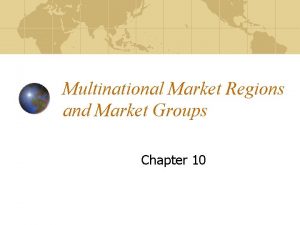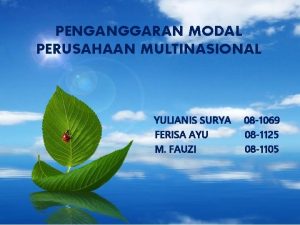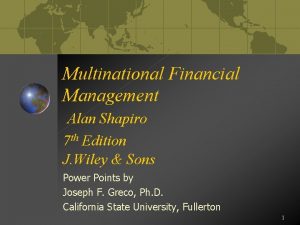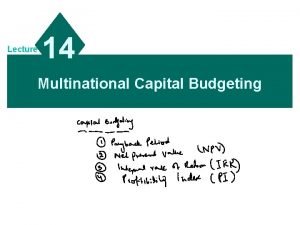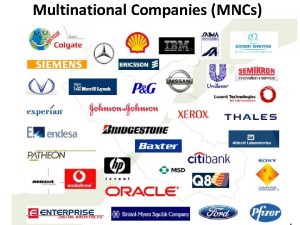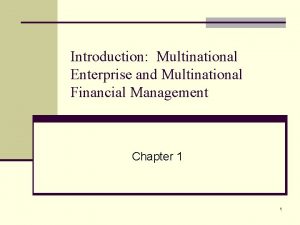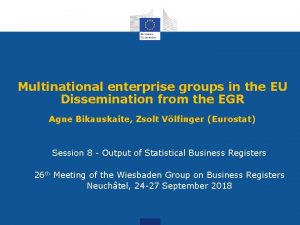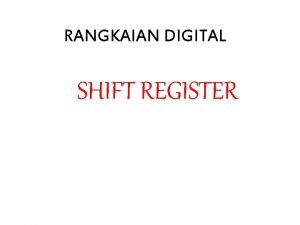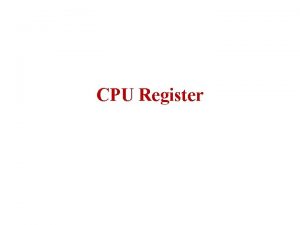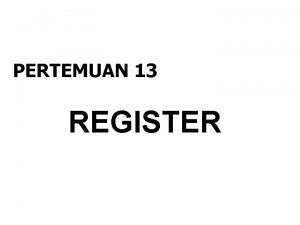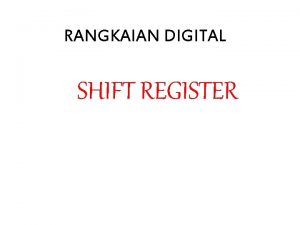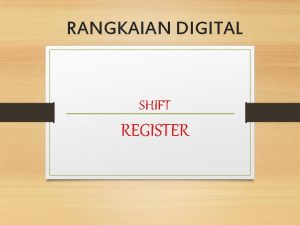EUROGROUPS REGISTER A register on Multinational Enterprise groups













- Slides: 13

EUROGROUPS REGISTER A register on Multinational Enterprise groups Wiesbaden 22 April 2008

Content n The Euro. Groups Register (EGR) – – – Background Objectives Benefits Content Process n State of the art of the project n Some reflections on the future Wiesbaden 22 April 2008

Background n Need for figures on impact of Multi National Enterprise groups (MNE’s) on national economies. n How to assure an accurate measurement? n Worldwide statistical office or ways of working based on sharing information provided by a headquarter of an MNE? n A register of MNE’s: an instrument for a better measurement. Wiesbaden 22 April 2008

Legal basis n Regulation (No 177/2008) of the EP and the Council on a business register for statistical purposes n Follow up: implementing regulations on: – Exchange of confidential data between Eurostat and National Statistical Institutes, National Banks and ECB – Measures related to data quality management Wiesbaden 22 April 2008

Objectives of the EGR n A unique platform to organise, coordinate and support of data collection and production of statistics on globalisation in Member States and Eurostat n A unique facility for integration and sharing of data from different sources n Facility for taking coordinated decisions on survey frames n A basis to produce demographic statistics on MNE’s Wiesbaden 22 April 2008

EGR: an efficient solution Design based on integration of data from different sources (private as well as public) – At least 2 private sources (using the same commercially successful concept: integrating data from different sources complemented with own data quality management) – National statistical organisations as source Wiesbaden 22 April 2008

EGR: an efficient solution Cost efficient acquisition of commercial data by central procurement Cost efficient development and operation of technical infrastructure for integrating data from several sources A standardised data model reducing communication costs with statistical organisations as well as MNE’s Wiesbaden 22 April 2008

EGR: an effective solution Survey frames can be co-ordinated by facilitating decision procedures on the basis of the subsidiarity principle. For Inward and outward FATS: Ultimate Controlling Institutional unit (UCI) Wiesbaden 22 April 2008

An example: Carnival n Carnival Corporation (USA) and Carnival plc (UK) function as a single economic entity (= 1 MNE) through contractual agreements between separate legal entities n In database of private sources: 2 MNE’s n In Germany: AIDA – UK = country of UCI (according to Bv. D) n In United Kingdom: Carnival plc (head) and subsidiaries: P&O – UK = country of UCI (according to Dn. B). After UK investigation of public sources: USA = country of UCI Conclusion: without sharing information/decisions population frames and FATS statistics will show over- and under coverage Wiesbaden 22 April 2008

Content of the EGR n World wide structure of MNE’s which operate in EU – Control relationships – Share holder information (10% or more) n Main units – – Global enterprise group National enterprise group Enterprise (EU) Legal units n Main characteristics: – – – Activity Persons employed Turnover Balance sheet total Country of UCI Institutional sector Wiesbaden 22 April 2008

Flow of information INPUT OUTPUT EGR network Data from NSI & NCB By By Eurostat: NSI/NCB: from Integrated network of Data on enterprise groups Data quality management import, Data EU and standardisation, checking national transformation, and linking, completion integration NSI NCB Euro. Groups Eurostat Registers ECB commercial providers Data collection Standardisation Linking Integration Data checking Compilation of population frames Use of population frames

Time table November 2008 December 2008 February 2009 April 2009 October 2009 Wiesbaden 22 April 2008 n Acquisition of commercial data on 5000 largest enterprise groups (2 providers) n Start with the EGR operations n Start with the process of matching of the units in the EGR with the units in the national registers n Start with data quality management n First population frame of MNE’s available according to the situation end of 2008

Some reflections on the future n Extending sharing register data on MNE’s with important and ‘safe’ non-EU countries? (discussion platform: Wiesbaden group). n Relevancy and quality of statistics can be improved by using ‘Business profiling’ for the top 500 MNE’s. n The development of a reference database with data from consolidated yearly accounts for the top 500 MNE’s could support the national compilers to produce national statistics which are mutually consistent. Wiesbaden 22 April 2008
 Eurogroups register
Eurogroups register Multinational market groups form
Multinational market groups form How are ethnic groups and religious groups related
How are ethnic groups and religious groups related Putting the enterprise into the enterprise system
Putting the enterprise into the enterprise system Putting the enterprise into the enterprise system
Putting the enterprise into the enterprise system Riverside permit portal
Riverside permit portal Multinational capital budgeting
Multinational capital budgeting Multinational financial management definition
Multinational financial management definition Objectives of multinational corporations
Objectives of multinational corporations Expanded opportunity set international finance
Expanded opportunity set international finance International or multinational
International or multinational Multinational cost of capital and capital structure
Multinational cost of capital and capital structure Multinational capital budgeting
Multinational capital budgeting Disadvantages of mncs
Disadvantages of mncs

